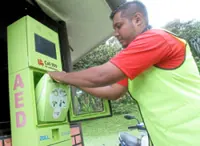Pressing down on someone's chest in time to the song "Stayin' Alive" by the Bee Gees will result in about 100 compressions a minute, the ideal rate for performing CPR. — dpa
A person's chance of surviving while receiving cardiopulmonary resuscitation (CPR) for cardiac arrest in hospital declines rapidly from 22% after one minute to less than 1% after 39 minutes, finds an recent American study published by The BMJ.
Similarly, the likelihood of leaving hospital with no major brain damage declines from 15% after one minute of CPR to less than 1% after 32 minutes with no heartbeat.




